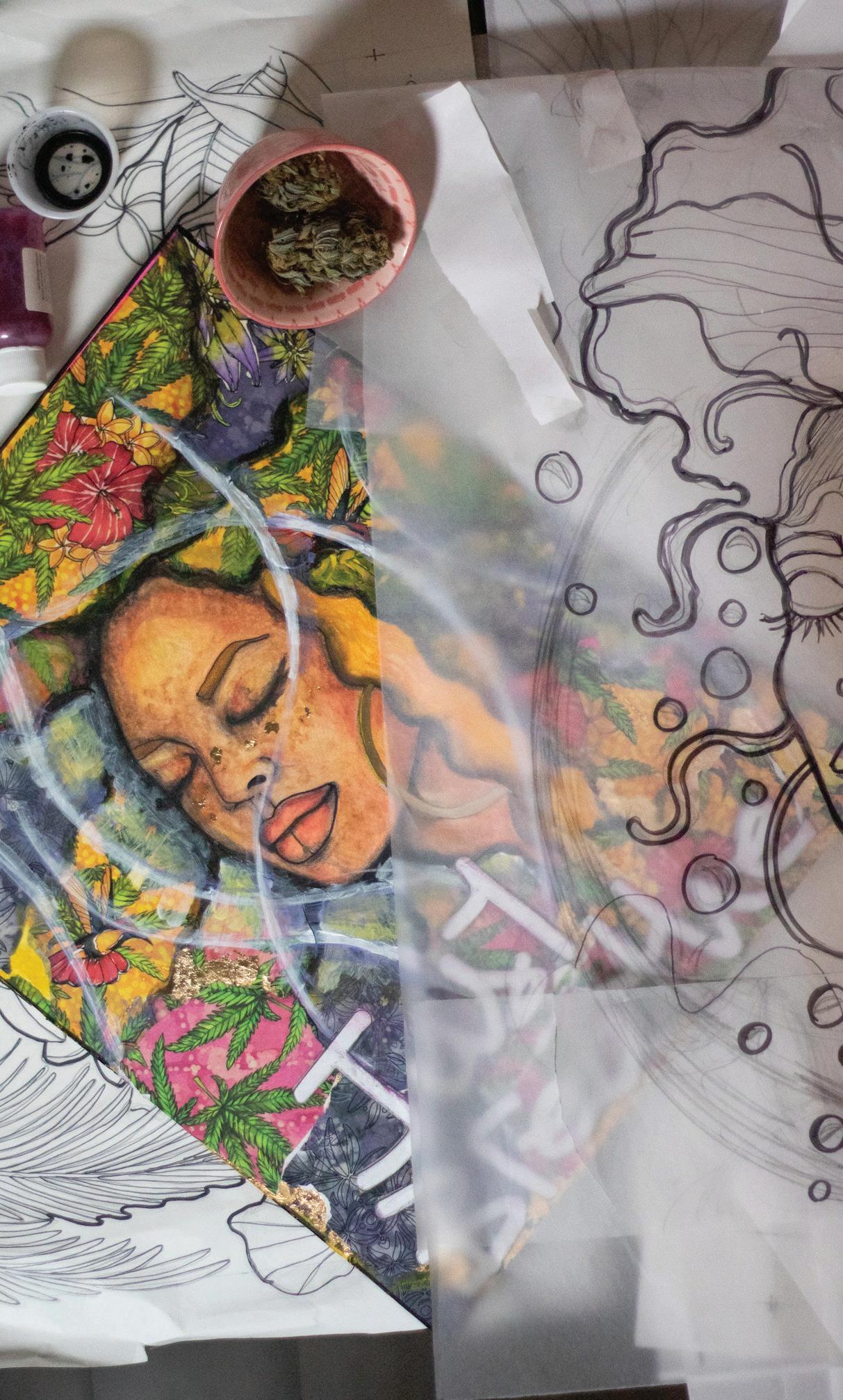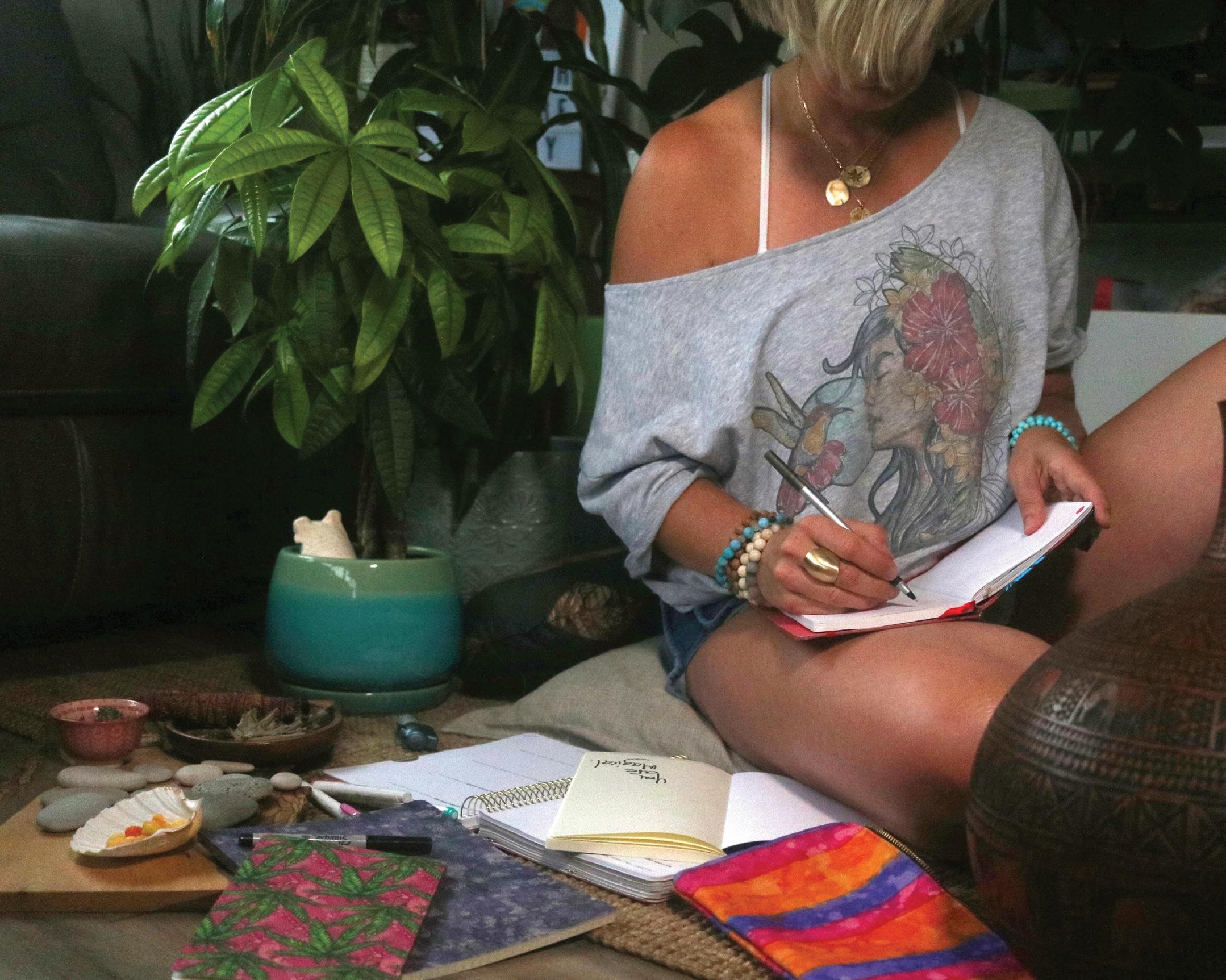
4 minute read
Gabrielle Lasporte
OH, THAT'S dope!
WHEN AN ANCIENT ART PRACTICE MEETS AN ANCIENT PLANT PRACTICE
Advertisement
BY STEPHANIE DELACY
Within one minute of meeting Gabrielle Lasporte on a virtual platform, I could tell she is a busy artist, occasionally enjoys cannabis, and is warmly authentic. Authenticity is essential with the work Lasporte does, which is Modern Batik - a wax technique using fabric dyes as the medium. One of her cannabis-inspired designs graces the back cover of this issue, so we asked her how the plant plays a part in the creative process.
Once we introduced ourselves, Lasporte immediately pointed out that she was covered in paint, while bringing her paint-speckled arms and hands to the camera. After we both chuckled, Lasportle looked down at her desk, quickly popping back up, holding a packet of rolling papers to show me, and say while laughing, “I am trying to teach myself to roll joints.”
Born in France, Lasporte moved to Canada when she was eight years old and has lived there ever since. For over twenty years, Lasporte has worked as a freelance Art Director and Creative Director for corporate clients. Having been an artist throughout her life, in different capacities, Lasporte has worked in several mediums. Those mediums include paint, acrylic, and collage. In 2008, she found a new medium – batik.
JEWELRY / jennygreco.com / @jennygrecojewellery PHOTOGRAPHY / Sharifah Weir - She shot that Photography /@she.shot.that

BATIK IS A TECHNIQUE OF WAXRESISTANT DYEING APPLIED TO
FABRICS IN LAYERS. ORIGINATING IN JAVA, INDONESIA, BATIK DATES BACK AS EARLY AS THE 6TH OR 7TH CENTURY. IN THE MODERN BATIK TECHNIQUE, THE ARTIST APPLIES WAX TO A BLANK UNDYED FABRIC, CREATING A PATTERN OR DESIGN. THEN IN A MULTI-LAYERED PROCESS, THE ARTIST APPLIES DYE DIRECTLY TO THE MATERIAL USING A BRUSH, KNOWN AS SECTIONING AND TONING.
AFTER THE SECTIONING AND TONING, THE ARTIST WILL SEAL IT WITH WAX. THIS LAYERED PROCESS REPEATS ALMOST A DOZEN TIMES. AFTER ALL THE LAYERS ARE APPLIED, THE WAX IS REMOVED TO REVEAL THE FINAL PATTERN OR DESIGN.
In traditional batik, the artist dips fabric into large containers of dye. “I learned modern batik. Instead of dipping, I apply the dye with brushes.” After two years of working in batik, Lasporte wanted to deepen her practice and started using traditional tools, including the tjanting, to dispense wax. “I wanted to pay homage because it’s not from my culture. I want to do it properly and be respectful of it,” Lasporte says. Batik is an incredibly methodical process. Compared to other art forms, it takes a lot of planning. The intricate process is what connected Lasporte to batik. “I never had this connection [to a medium] before. It’s very soothing. I end up romanticizing my thoughts around the art form,” Lasporte shares.
Lasporte has developed her approach to creating batik – and cannabis has become an essential part of her intimate ritual through the years. Lasporte’s ritual starts by making herself comfortable on the couch. While listening to deep house music, she smokes her bong. Slipping into a natural flow, she writes and sketches out ideas in her Superwoman-themed notebook.
Despite the plant playing a role in the process, Lasporte clarifies she doesn’t smoke cannabis when creating. The plant helps Lasporte relax


and enhances her creativity, but she doesn’t rely on it. Lasporte only uses it in the conceptualization stage of her artistic process. She also uses it for managing migraines and symptoms of menopause. Lasporte discovered how potent cannabis could be when creating art through meaningful self-work and experimenting with different strains. Through experimentation, Lasporte found that cannabis made her work highly creative and spiritual. Beyond cannabis, Lasporte says her work is “goddess inspired” and is also inspired by the female form, tropical plants, and music.
After conceptualizing a piece, Lasporte heads to her studio to breathe life into it. Working with uncontrollable wax makes the process of batik unpredictable. “The thing about batik is that it never turns out the way you think it will,” Lasporte says, “I work with the wax - that’s what I love about it.”
Her latest collection is called Canna Botanique: a line of plant-inspired designs created to challenge the popculture idea of cannabis fashion. Lasporte, who likes to do things differently, uses her batik process to move beyond the iconic leaf to showcase the beauty of the plant. She incorporates vibrant colors juxtapositioned with her iconic hibiscus flowers in her Canna Tropico pattern. Then she flips it with a damask pattern in deep purple, with her version of the cannabis “buds” or flowers, inspired by the Purple Haze cannabis strain.
“The way I create the batik, it changes up the image visually. I emphasize that when I do the work. So you're going to look at it and be like, Oh, that's dope,” shares Lasporte.
EXPLORE THE ENTIRE CANNA BOTANIQUE COLLECTION AT:
GABRIELLELASPORTE.COM
YOU CAN FIND GABRIELLE ON INSTAGRAM:









